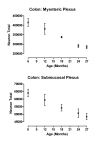Innervation of the gastrointestinal tract: patterns of aging
- PMID: 17537681
- PMCID: PMC2045700
- DOI: 10.1016/j.autneu.2007.04.005
Innervation of the gastrointestinal tract: patterns of aging
Abstract
The gastrointestinal (GI) tract is innervated by intrinsic enteric neurons and by extrinsic projections, including sympathetic and parasympathetic efferents as well as visceral afferents, all of which are compromised by age to different degrees. In the present review, we summarize and illustrate key structural changes in the aging innervation of the gut, and suggest a provisional list of the general patterns of aging of the GI innervation. For example, age-related neuronal losses occur in both the myenteric plexus and submucosal plexus of the intestines. These losses start in adulthood, increase over the rest of the life span, and are specific to cholinergic neurons. Parallel losses of enteric glia also occur. The extent of neuronal and glial loss varies along an oral-to-anal gradient, with the more distal GI tract being more severely affected. Additionally, with aging, dystrophic axonal swellings and markedly dilated varicosities progressively accumulate in the sympathetic, vagal, dorsal root, and enteric nitrergic innervation of the gut. These dramatic and consistent patterns of neuropathy that characterize the aging autonomic nervous system of the GI tract are candidate mechanisms for some of the age-related declines in function evidenced in the elderly.
Figures










References
-
- Abalo R, Jose Rivera A, Vera G, Isabel Martin M. Ileal myenteric plexus in aged guinea-pigs: loss of structure and calretinin-immunoreactive neurones. Neurogastroenterol Motil. 2005;17:123–132. - PubMed
-
- Baker DM, Santer RM. A quantitative study of the effects of age on the noradrenergic innervation of Auerbach’s plexus in the rat. Mech Ageing Dev. 1988a;42:147–158. - PubMed
-
- Baker DM, Santer RM. Morphometric studies on pre- and paravertebral sympathetic neurons in the rat: changes with age. Mech Ageing Dev. 1988b;42:139–145. - PubMed
-
- Bassotti G, De Giorgio R, Stanghellini V, Tonini M, Barbara G, Salvioli B, Fiorella S, Corinaldesi R. Constipation: a common problem in patients with neurological abnormalities. Ital J Gastroenterol Hepatol. 1998;30:542–548. - PubMed
-
- Belai A, Cooper S, Burnstock G. Effect of age on NADPH-diaphorase-containing myenteric neurones of rat ileum and proximal colon. Cell Tissue Res. 1995;279:379–383. - PubMed
Publication types
MeSH terms
Grants and funding
LinkOut - more resources
Full Text Sources
Medical

